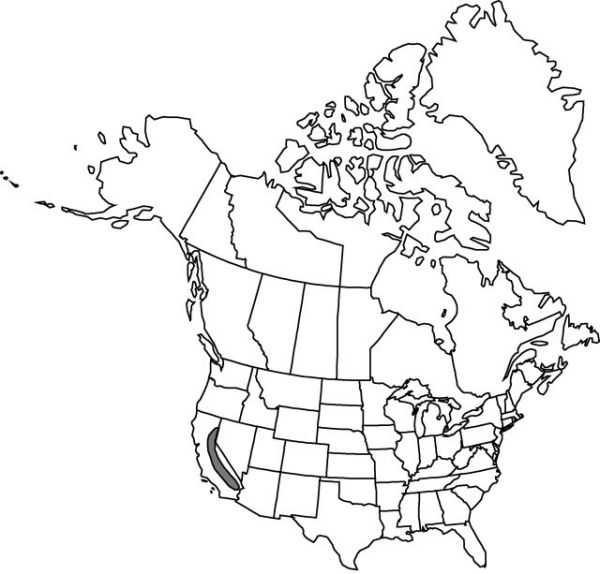Difference between revisions of "Iris hartwegii"
Gard. Chron., n. s. 6: 323. 1876.
FNA>Volume Importer |
imported>Volume Importer |
||
| (6 intermediate revisions by 2 users not shown) | |||
| Line 8: | Line 8: | ||
}} | }} | ||
|common_names=Sierra iris | |common_names=Sierra iris | ||
| + | |special_status={{Treatment/ID/Special_status | ||
| + | |code=E | ||
| + | |label=Endemic | ||
| + | }} | ||
|basionyms= | |basionyms= | ||
|synonyms={{Treatment/ID/Synonym | |synonyms={{Treatment/ID/Synonym | ||
|name=Iris hartwegii subsp. australis | |name=Iris hartwegii subsp. australis | ||
|authority=(Parish) L. W. Lenz | |authority=(Parish) L. W. Lenz | ||
| − | }}{{Treatment/ID/Synonym | + | |rank=subspecies |
| + | }} {{Treatment/ID/Synonym | ||
|name=Iris hartwegii var. australis | |name=Iris hartwegii var. australis | ||
|authority=Parish | |authority=Parish | ||
| − | }}{{Treatment/ID/Synonym | + | |rank=variety |
| + | }} {{Treatment/ID/Synonym | ||
|name=Iris hartwegii subsp. columbiana | |name=Iris hartwegii subsp. columbiana | ||
|authority=L. W. Lenz | |authority=L. W. Lenz | ||
| − | }}{{Treatment/ID/Synonym | + | |rank=subspecies |
| + | }} {{Treatment/ID/Synonym | ||
|name=Iris hartwegii subsp. pinetorum | |name=Iris hartwegii subsp. pinetorum | ||
|authority=(Eastwood) L. W. Lenz | |authority=(Eastwood) L. W. Lenz | ||
| − | }}{{Treatment/ID/Synonym | + | |rank=subspecies |
| + | }} {{Treatment/ID/Synonym | ||
|name=Iris pinetorum | |name=Iris pinetorum | ||
| − | |authority= | + | |authority= |
| + | |rank=species | ||
}} | }} | ||
|hierarchy=Iridaceae;Iris;Iris subg. Limniris;Iris sect. Limniris;Iris (sect. Limniris) ser. Californicae;Iris hartwegii | |hierarchy=Iridaceae;Iris;Iris subg. Limniris;Iris sect. Limniris;Iris (sect. Limniris) ser. Californicae;Iris hartwegii | ||
| Line 38: | Line 47: | ||
|habitat=Yellow-pine forests on sunny or partially shaded slopes | |habitat=Yellow-pine forests on sunny or partially shaded slopes | ||
|distribution=Calif. | |distribution=Calif. | ||
| − | |discussion=<p>Plants with pedicels 2.8–4.7 cm, and flowers light purple or bluish violet have been recognized as subsp. australis. Plants having a 3-flowered inflorescence unit, leaves about 1 cm wide, and pale yellow flowers with golden yellow veining have been called subsp. columbiana. Plants having both flowers open at the same time rather than consecutively, pedicels averaging only 1 cm, long narrow style arms and crests, and floral tubes 1.2–1.5 cm have been named subsp. pinetorum.</p><!-- | + | |discussion=<p>Plants with pedicels 2.8–4.7 cm, and flowers light purple or bluish violet have been recognized as <i></i>subsp.<i> australis</i>. Plants having a 3-flowered inflorescence unit, leaves about 1 cm wide, and pale yellow flowers with golden yellow veining have been called subsp. columbiana. Plants having both flowers open at the same time rather than consecutively, pedicels averaging only 1 cm, long narrow style arms and crests, and floral tubes 1.2–1.5 cm have been named <i></i>subsp.<i> pinetorum</i>.</p><!-- |
| − | --><p>Iris hartwegii hybridizes with I. douglasiana, I. innominata, I. macrosiphon, I. munzii, I. tenax, and I. tenuissima. It is known from Butte County to Kern County.</p> | + | --><p><i>Iris hartwegii</i> hybridizes with <i>I. douglasiana</i>, <i>I. innominata</i>, <i>I. macrosiphon</i>, <i>I. munzii</i>, <i>I. tenax</i>, and <i>I. tenuissima</i>. It is known from Butte County to Kern County.</p> |
|tables= | |tables= | ||
|references= | |references= | ||
| Line 48: | Line 57: | ||
-->{{#Taxon: | -->{{#Taxon: | ||
name=Iris hartwegii | name=Iris hartwegii | ||
| − | |||
|authority=Baker | |authority=Baker | ||
|rank=species | |rank=species | ||
| Line 61: | Line 69: | ||
|publication title=Gard. Chron., n. s. | |publication title=Gard. Chron., n. s. | ||
|publication year=1876 | |publication year=1876 | ||
| − | |special status= | + | |special status=Endemic |
| − | |source xml=https:// | + | |source xml=https://bitbucket.org/aafc-mbb/fna-data-curation/src/2e0870ddd59836b60bcf96646a41e87ea5a5943a/coarse_grained_fna_xml/V26/V26_786.xml |
|genus=Iris | |genus=Iris | ||
|subgenus=Iris subg. Limniris | |subgenus=Iris subg. Limniris | ||
Latest revision as of 21:17, 5 November 2020
Rhizomes creeping, not producing dense clumps, covered with remains of old leaves, slender to moderately thick, 0.5–0.9 cm diam.; roots fibrous. Stems simple, solid, 0.5–3 dm. Leaves: basal deciduous, blade pale green, not pink basally, 2–4.5 dm × 0.2–0.6(–1) cm, sometimes glaucous, margins not thickened; cauline usually 1–several, spreading, sheathing for about 1/2 length, foliaceous, blade not inflated. Inflorescence units 1–2(–3)-flowered; spathes divergent, separated by 1.5–4 cm, linear to linear-lanceolate, unequal, outer 5–11 cm × 4–7 mm, inner 5–6 cm × 2–3 mm, herbaceous, apex acute. Flowers: perianth lavender, cream, or pale to deep yellow; floral tube funnelform, 0.5–1(–1.5) cm; sepals oblanceolate, 4–7 × 1.4–2 cm, base gradually attenuate; petals narrowly oblanceolate, 3.5–6 × 0.5–1.1 cm, widest at about 1/2 their length, base abruptly attenuate, claw 1–2 mm wide; ovary nearly cylindrical, 1–2 cm; style 1.6–3 cm, crests overlapping, obtusely angled, 0.5–1.1 cm; stigmas acutely triangular, margins entire; pedicel 0.5–2.5 cm at anthesis, lengthening to 3.5–7.5 cm at maturity. Capsules oblong-oval, 3-angled, tapering abruptly at either end, 2–3 cm. Seeds brown, irregularly D-shaped, wrinkled. 2n = 40.
Phenology: Flowering Jun.
Habitat: Yellow-pine forests on sunny or partially shaded slopes
Discussion
Plants with pedicels 2.8–4.7 cm, and flowers light purple or bluish violet have been recognized as subsp. australis. Plants having a 3-flowered inflorescence unit, leaves about 1 cm wide, and pale yellow flowers with golden yellow veining have been called subsp. columbiana. Plants having both flowers open at the same time rather than consecutively, pedicels averaging only 1 cm, long narrow style arms and crests, and floral tubes 1.2–1.5 cm have been named subsp. pinetorum.
Iris hartwegii hybridizes with I. douglasiana, I. innominata, I. macrosiphon, I. munzii, I. tenax, and I. tenuissima. It is known from Butte County to Kern County.
Selected References
None.
